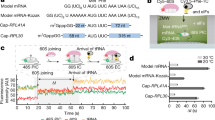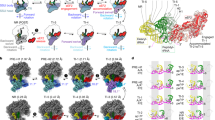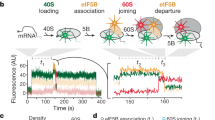Abstract
Translation elongation factors facilitate protein synthesis by the ribosome. Previous studies identified two universally conserved translation elongation factors, EF-Tu in bacteria (known as eEF1A in eukaryotes) and EF-G (eEF2), which deliver aminoacyl-tRNAs to the ribosome and promote ribosomal translocation, respectively1. The factor eIF5A (encoded by HYP2 and ANB1 in Saccharomyces cerevisiae), the sole protein in eukaryotes and archaea to contain the unusual amino acid hypusine (Nε-(4-amino-2-hydroxybutyl)lysine)2, was originally identified based on its ability to stimulate the yield (endpoint) of methionyl-puromycin synthesis—a model assay for first peptide bond synthesis thought to report on certain aspects of translation initiation3,4. Hypusine is required for eIF5A to associate with ribosomes5,6 and to stimulate methionyl-puromycin synthesis7. Because eIF5A did not stimulate earlier steps of translation initiation8, and depletion of eIF5A in yeast only modestly impaired protein synthesis9, it was proposed that eIF5A function was limited to stimulating synthesis of the first peptide bond or that eIF5A functioned on only a subset of cellular messenger RNAs. However, the precise cellular role of eIF5A is unknown, and the protein has also been linked to mRNA decay, including the nonsense-mediated mRNA decay pathway10,11, and to nucleocytoplasmic transport12,13. Here we use molecular genetic and biochemical studies to show that eIF5A promotes translation elongation. Depletion or inactivation of eIF5A in the yeast S. cerevisiae resulted in the accumulation of polysomes and an increase in ribosomal transit times. Addition of recombinant eIF5A from yeast, but not a derivative lacking hypusine, enhanced the rate of tripeptide synthesis in vitro. Moreover, inactivation of eIF5A mimicked the effects of the eEF2 inhibitor sordarin, indicating that eIF5A might function together with eEF2 to promote ribosomal translocation. Because eIF5A is a structural homologue of the bacterial protein EF-P14,15, we propose that eIF5A/EF-P is a universally conserved translation elongation factor.
This is a preview of subscription content, access via your institution
Access options
Subscribe to this journal
Receive 51 print issues and online access
$199.00 per year
only $3.90 per issue
Buy this article
- Purchase on Springer Link
- Instant access to full article PDF
Prices may be subject to local taxes which are calculated during checkout




Similar content being viewed by others
References
Merrick, W. C. & Nyborg, J. in Translational Control of Gene Expression (eds Sonenberg, N., Hershey, J. W. B. & Mathews, M. B.) 89–125 (Cold Spring Harbor Laboratory Press, 2000)
Wolff, E. C., Kang, K. R., Kim, Y. S. & Park, M. H. Posttranslational synthesis of hypusine: evolutionary progression and specificity of the hypusine modification. Amino Acids 33, 341–350 (2007)
Kemper, W. M., Berry, K. W. & Merrick, W. C. Purification and properties of rabbit reticulocyte protein synthesis initiation factors M2Bα and M2Bβ. J. Biol. Chem. 251, 5551–5557 (1976)
Schreier, M. H., Erni, B. & Staehelin, T. Initiation of mammalian protein synthesis: purification and characterization of seven initiation factors. J. Mol. Biol. 116, 727–753 (1977)
Jao, D. L. & Chen, K. Y. Tandem affinity purification revealed the hypusine-dependent binding of eukaryotic initiation factor 5A to the translating 80S ribosomal complex. J. Cell. Biochem. 97, 583–598 (2006)
Zanelli, C. F. et al. eIF5A binds to translational machinery components and affects translation in yeast. Biochem. Biophys. Res. Commun. 348, 1358–1366 (2006)
Park, M. H., Wolff, E. C., Smit-McBride, Z., Hershey, J. W. & Folk, J. E. Comparison of the activities of variant forms of eIF-4D. The requirement for hypusine or deoxyhypusine. J. Biol. Chem. 266, 7988–7994 (1991)
Benne, R. & Hershey, J. W. B. The mechanism of action of protein synthesis initiation factors from rabbit reticulocytes. J. Biol. Chem. 253, 3078–3087 (1978)
Kang, H. A. & Hershey, J. W. Effect of initiation factor eIF-5A depletion on protein synthesis and proliferation of Saccharomyces cerevisiae . J. Biol. Chem. 269, 3934–3940 (1994)
Schrader, R., Young, C., Kozian, D., Hoffmann, R. & Lottspeich, F. Temperature-sensitive eIF5A mutant accumulates transcripts targeted to the nonsense-mediated decay pathway. J. Biol. Chem. 281, 35336–35346 (2006)
Zuk, D. & Jacobson, A. A single amino acid substitution in yeast eIF-5A results in mRNA stabilization. EMBO J. 17, 2914–2925 (1998)
Ruhl, M. et al. Eukaryotic initiation factor 5A is a cellular target of the human immunodeficiency virus type 1 Rev activation domain mediating trans-activation. J. Cell Biol. 123, 1309–1320 (1993)
Zanelli, C. F. & Valentini, S. R. Is there a role for eIF5A in translation? Amino Acids 33, 351–358 (2007)
Hanawa-Suetsugu, K. et al. Crystal structure of elongation factor P from Thermus thermophilus HB8. Proc. Natl Acad. Sci. USA 101, 9595–9600 (2004)
Kyrpides, N. C. & Woese, C. R. Universally conserved translation initiation factors. Proc. Natl Acad. Sci. USA 95, 224–228 (1998)
Jivotovskaya, A. V., Valasek, L., Hinnebusch, A. G. & Nielsen, K. H. Eukaryotic translation initiation factor 3 (eIF3) and eIF2 can promote mRNA binding to 40S subunits independently of eIF4G in yeast. Mol. Cell. Biol. 26, 1355–1372 (2006)
Smirnov, V. N. et al. Recessive nonsense-suppression in yeast: further characterization of a defect in translation. FEBS Lett. 66, 12–15 (1976)
Anand, M., Chakraburtty, K., Marton, M. J., Hinnebusch, A. G. & Kinzy, T. G. Functional interactions between yeast translation eukaryotic elongation factor (eEF) 1A and eEF3. J. Biol. Chem. 278, 6985–6991 (2003)
Ortiz, P. A. & Kinzy, T. G. Dominant-negative mutant phenotypes and the regulation of translation elongation factor 2 levels in yeast. Nucleic Acids Res. 33, 5740–5748 (2005)
Fan, H. & Penman, S. Regulation of protein synthesis in mammalian cells. II. Inhibition of protein synthesis at the level of initiation during mitosis. J. Mol. Biol. 50, 655–670 (1970)
Nielsen, P. J. & McConkey, E. H. Evidence for control of protein synthesis in HeLa cells via the elongation rate. J. Cell. Physiol. 104, 269–281 (1980)
Acker, M. G., Kolitz, S. E., Mitchell, S. F., Nanda, J. S. & Lorsch, J. R. Reconstitution of yeast translation initiation. Methods Enzymol. 430, 111–145 (2007)
Youngman, E. M., McDonald, M. E. & Green, R. Peptide release on the ribosome: mechanism and implications for translational control. Annu. Rev. Microbiol. 62, 353–373 (2008)
Harger, J. W., Meskauskas, A., Nielsen, J., Justice, M. C. & Dinman, J. D. Ty1 retrotransposition and programmed +1 ribosomal frameshifting require the integrity of the protein synthetic translocation step. Virology 286, 216–224 (2001)
Zhang, S. et al. Polysome-associated mRNAs are substrates for the nonsense-mediated mRNA decay pathway in Saccharomyces cerevisiae . RNA 3, 234–244 (1997)
Glick, B. R. & Ganoza, M. C. Identification of a soluble protein that stimulates peptide bond synthesis. Proc. Natl Acad. Sci. USA 72, 4257–4260 (1975)
Ganoza, M. C. & Aoki, H. Peptide bond synthesis: function of the efp gene product. Biol. Chem. 381, 553–559 (2000)
Dohmen, R. J., Wu, P. & Varshavsky, A. Heat-inducible degron: a method for constructing temperature-sensitive mutants. Science 263, 1273–1276 (1994)
Labib, K., Tercero, J. A. & Diffley, J. F. Uninterrupted MCM2–7 function required for DNA replication fork progression. Science 288, 1643–1647 (2000)
Harger, J. W. & Dinman, J. D. An in vivo dual-luciferase assay system for studying translational recoding in the yeast Saccharomyces cerevisiae . RNA 9, 1019–1024 (2003)
Gietz, R. D. & Sugino, A. New yeast–Escherichia coli shuttle vectors constructed with in vitro mutagenized yeast genes lacking six-base pair restriction sites. Gene 74, 527–534 (1988)
Tong, A. H. et al. Systematic genetic analysis with ordered arrays of yeast deletion mutants. Science 294, 2364–2368 (2001)
Shenton, D. et al. Global translational responses to oxidative stress impact upon multiple levels of protein synthesis. J. Biol. Chem. 281, 29011–29021 (2006)
Tarun, S. Z. & Sachs, A. B. A common function for mRNA 5′ and 3′ ends in translation initiation in yeast. Genes Dev. 9, 2997–3007 (1995)
Gallie, D. R., Feder, J. N., Schimke, R. T. & Walbot, V. Post-transcriptional regulation in higher eukaryotes: the role of the reporter gene in controlling expression. Mol. Gen. Genet. 228, 258–264 (1991)
Acknowledgements
We thank T. G. Kinzy for providing anti-yeast eEF1A, eEF2 and eEF3 antisera, as well as constructs for the purification of eEF2 and eEF3; J. Lorsch for providing constructs for purification of yeast initiation factors; J. Dinmann for frameshifting reporter vectors, and A. Hinnebusch, T. G. Kinzy, A. Jivotovskaya, D. Shelton, C. Grant, J. Lorsch and members of the Dever and Hinnebusch laboratories for comments and discussion. Salary support provided by HHMI (R.G.) and NIH (D.E.E.). This work was supported in part by the Intramural Research Program of the NIH, NICHD (to T.E.D.).
Author Contributions P.S., D.E.E., R.G. and T.E.D. designed the experiments and wrote the manuscript. P.S. performed all experiments except reconstituted translation experiments, which were performed by D.E.E.
Author information
Authors and Affiliations
Corresponding author
Supplementary information
Supplementary Information
This file contains Supplementary Tables 1-2, Supplementary Figures 1-5 with Legends and Supplementary References. (PDF 8689 kb)
Rights and permissions
About this article
Cite this article
Saini, P., Eyler, D., Green, R. et al. Hypusine-containing protein eIF5A promotes translation elongation. Nature 459, 118–121 (2009). https://doi.org/10.1038/nature08034
Received:
Accepted:
Issue Date:
DOI: https://doi.org/10.1038/nature08034
This article is cited by
-
SUMOylation modulates eIF5A activities in both yeast and pancreatic ductal adenocarcinoma cells
Cellular & Molecular Biology Letters (2024)
-
Eukaryotic Initiation Factor 5A2 localizes to actively translating ribosomes to promote cancer cell protrusions and invasive capacity
Cell Communication and Signaling (2023)
-
A molecular network of conserved factors keeps ribosomes dormant in the egg
Nature (2023)
-
Targeted inhibition of eIF5Ahpu suppresses tumor growth and polarization of M2-like tumor-associated macrophages in oral cancer
Cell Death & Disease (2023)
-
Insights into the ribosome function from the structures of non-arrested ribosome–nascent chain complexes
Nature Chemistry (2023)
Comments
By submitting a comment you agree to abide by our Terms and Community Guidelines. If you find something abusive or that does not comply with our terms or guidelines please flag it as inappropriate.



